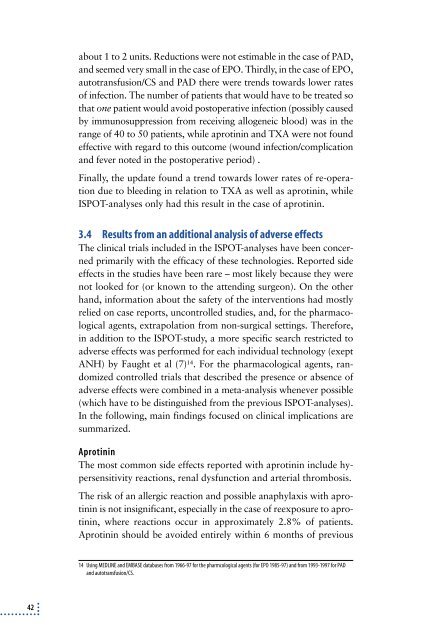Elektronisk udgave - Sundhedsstyrelsen
Elektronisk udgave - Sundhedsstyrelsen
Elektronisk udgave - Sundhedsstyrelsen
Create successful ePaper yourself
Turn your PDF publications into a flip-book with our unique Google optimized e-Paper software.
42<br />
about 1 to 2 units. Reductions were not estimable in the case of PAD,<br />
and seemed very small in the case of EPO. Thirdly, in the case of EPO,<br />
autotransfusion/CS and PAD there were trends towards lower rates<br />
of infection. The number of patients that would have to be treated so<br />
that one patient would avoid postoperative infection (possibly caused<br />
by immunosuppression from receiving allogeneic blood) was in the<br />
range of 40 to 50 patients, while aprotinin and TXA were not found<br />
effective with regard to this outcome (wound infection/complication<br />
and fever noted in the postoperative period) .<br />
Finally, the update found a trend towards lower rates of re-operation<br />
due to bleeding in relation to TXA as well as aprotinin, while<br />
ISPOT-analyses only had this result in the case of aprotinin.<br />
3.4 Results from an additional analysis of adverse effects<br />
The clinical trials included in the ISPOT-analyses have been concerned<br />
primarily with the efficacy of these technologies. Reported side<br />
effects in the studies have been rare – most likely because they were<br />
not looked for (or known to the attending surgeon). On the other<br />
hand, information about the safety of the interventions had mostly<br />
relied on case reports, uncontrolled studies, and, for the pharmacological<br />
agents, extrapolation from non-surgical settings. Therefore,<br />
in addition to the ISPOT-study, a more specific search restricted to<br />
adverse effects was performed for each individual technology (exept<br />
ANH) by Faught et al (7) 14 . For the pharmacological agents, randomized<br />
controlled trials that described the presence or absence of<br />
adverse effects were combined in a meta-analysis whenever possible<br />
(which have to be distinguished from the previous ISPOT-analyses).<br />
In the following, main findings focused on clinical implications are<br />
summarized.<br />
Aprotinin<br />
The most common side effects reported with aprotinin include hypersensitivity<br />
reactions, renal dysfunction and arterial thrombosis.<br />
The risk of an allergic reaction and possible anaphylaxis with aprotinin<br />
is not insignificant, especially in the case of reexposure to aprotinin,<br />
where reactions occur in approximately 2.8% of patients.<br />
Aprotinin should be avoided entirely within 6 months of previous<br />
14 Using MEDLINE and EMBASE databases from 1966-97 for the pharmcological agents (for EPO 1985-97) and from 1993-1997 for PAD<br />
and autotransfusion/CS.

















